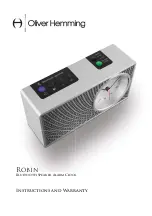
27
space entry (29 CFR 1910.146) explicitly requires
the use of direct reading, substance specific
sensors whenever a particular toxic hazard is
known to be likely to be present. If hydrogen
sulfide is known to be potentially present, one
of the toxic sensors selected should be
specifically for the detection of H
2
S, and
calibrated directly to this hazard.
The “CO Plus” sensor can be calibrated to either
hydrogen sulfide or carbon monoxide. In order to
change the type of gas used to calibrate the “CO
Plus” sensor, it is necessary to enter the
“Configuration Setup” menu as discussed in Chapter
4 and select the new calibration gas.
Do not use multi-component
calibration gas mixtures containing both carbon
monoxide and hydrogen sulfide when
calibrating a PhD Ultra with a CO Plus sensor
installed. Calibration of the CO Plus sensor
with multi-component calibration gas mixtures
containing both CO and H
2
S may lead to
inaccurate and potentially dangerous readings.
Biosystems multi-component calibration gas
mixtures containing both carbon monoxide and
hydrogen sulfide are labeled as “Not for use
with CO Plus sensors”.
Biosystems “CO Plus” sensors are designed for the
simultaneous detection of both carbon monoxide
and
hydrogen sulfide. “CO Plus” sensors may be
calibrated to either carbon monoxide or hydrogen
sulfide. The calibration gas used to calibrate “CO
Plus” sensors may contain only one or the other of
these two gases. Calibrating a “CO Plus” sensor
with a gas mixture containing both carbon monoxide
and hydrogen sulfide may produce dangerously low
readings.
Biosystems multi-component calibration gas
mixtures that contain both carbon monoxide and
hydrogen sulfide are labeled as “Not for use with CO
Plus sensors”.
With the CO Plus sensor, the
calibration gas setting determines whether the
instrument is configured for the direct reading
of CO, or for the direct reading of H
2
S.
Calibration gas corresponding to the direct
reading requirement must be used in the
calibration of the instrument. If carbon
monoxide is chosen in the calibration gas
setting option, the display will show CO+ and
carbon monoxide must be used to verify
accuracy. Similarly, if hydrogen sulfide is
chosen in the calibration gas setting option, the
instrument will display H
2
S+ and hydrogen
sulfide must be used to verify accuracy. Use of
the incorrect calibration gas may lead to
inaccurate and potentially dangerous readings.
If the sensor is calibrated to carbon monoxide the
current gas reading display will identify a “CO+”
sensor as currently installed and the PhD Ultra will
automatically use the alarm settings for carbon
monoxide. If hydrogen sulfide is chosen as the
calibration gas the display will identify the sensor
installed as an “H
2
S+” sensor and H
2
S alarm settings
will automatically be used.
3.1.2.1 Relative response of the “CO Plus”
sensor to carbon monoxide and
hydrogen sulfide
A properly calibrated “CO Plus” sensor will respond
accurately to the gas to which it is calibrated.
OSHA has assigned an 8-hour TWA of 35 PPM as
the permissible exposure limit for carbon monoxide.
If the “CO Plus” sensor is calibrated to carbon
monoxide and then exposed to 35 PPM carbon
monoxide, the reading will be 35 PPM.
The “CO Plus” sensor will also show a “relative
response” to other interfering gases. When
calibrated to carbon monoxide the relative response
of the “CO Plus” sensor to hydrogen sulfide is a ratio
of about 3.5 to 1.0. This means a concentration of
about 10 PPM hydrogen sulfide would produce a
“CO+” sensor reading of 10 X 3.5 or 35 PPM.
This is a very convenient relative response. The 8-
hour TWA permissible exposure limit for hydrogen
sulfide is 10 PPM. This means that the “CO+” gas
alarms will be tripped any time the concentration of
hydrogen sulfide exceeds the permissible exposure
limit.
Note: Cross sensitivity of the “CO Plus” sensor
to carbon monoxide, hydrogen sulfide and other
common interfering gases is listed in Appendix
E.
3.1.3 Choosing the correct calibration gas
mixture
The best results are obtained when calibration is
done using the same gas that is expected to be
encountered while actually using the instrument.
Sensor performance, calibration gas strategies
and “Propane Equivalent” calibration gas
mixtures are discussed in greater detail in
Appendix B. A listing of currently available
Biosystems calibration gas mixtures is
contained in Appendix D.
3.2
Fresh air "zero" calibration
The fresh air "zero" must be done in fresh,
uncontaminated air. In this procedure the
instrument automatically adjusts its oxygen,
combustible gas, and toxic gas readings to match
the concentrations present in fresh air (20.9 percent
O
2
, 0 percent LEL, 0 PPM toxic gas).
















































